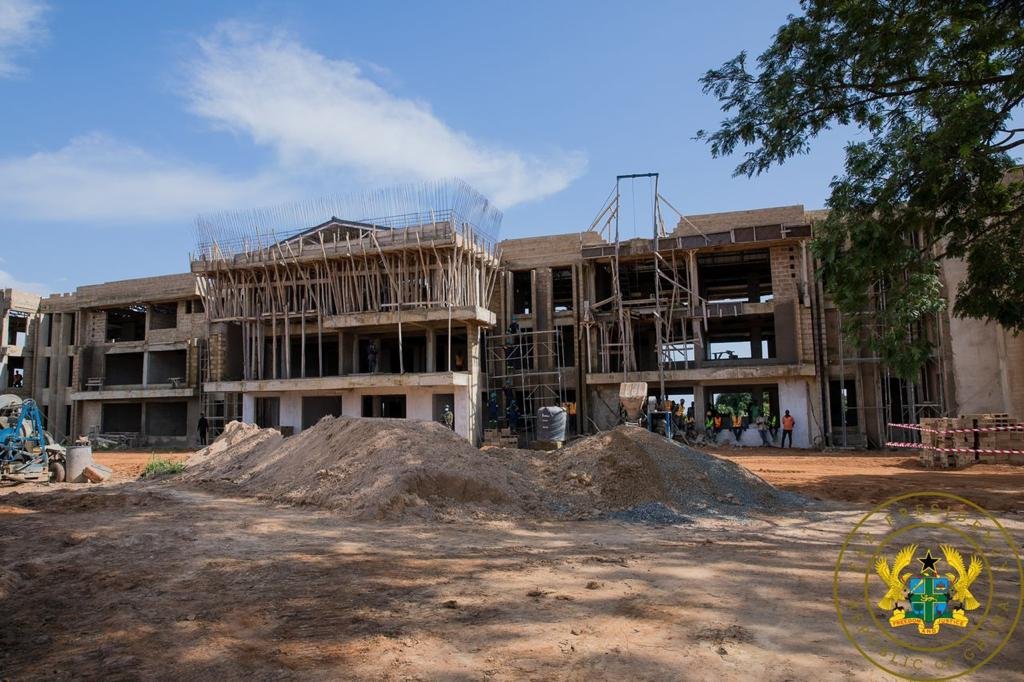
Picture taken at the last visit to the site of Oti RCC by Prez Akufo-Addo
It has been three years since President Nana Addo Dankwa Akufo-Addo’s audacious decision to create six new regions, a move that was met with both anticipation and scepticism. Now, as the dust settles, advocates for these new regions are taking stock of the developments and challenges that have unfolded in these administrative divisions since their inception.
President Akufo-Addo’s vision behind the creation of these regions was to bring government services closer to the people and promote equitable development across all sectors of the economy. However, a recent visit to these regions has shed light on the current state of affairs and challenges faced by these newly established regions.
Contrary to the government claims, some administrative tasks are still conducted in the old regions. For instance, individuals continue to travel from Oti to Ho, the Volta Regional Capital, for regional administrative work. This situation underscores concerns about the equitable distribution of resources and development among these regions.
Nonetheless, some makeshift districts were created from existing ones, and others were upgraded from districts to municipalities to facilitate the establishment of the new regions.
Despite the government’s intentional programs like “One District, One Factory” and “Planting for Food and Jobs,” which were meant to be extended to these regions to stimulate economic growth, it appears that these initiatives have not borne fruit in these areas. The flagship “Agenda 111” program has struggled to progress beyond the initial stages of groundbreaking and foundation laying.
- North East Region: The North East Region, carved out of the Upper East Region, has made significant strides in infrastructure development, with improved access to education and healthcare. However, challenges persist in addressing poverty and unemployment, although there is optimism about the region’s growth potential
2. Savannah Region: The creation of the Savannah Region, previously part of the Northern Region, aimed to bring development closer to the people. Efforts are underway to boost agriculture, promote tourism, and enhance education. Infrastructure development remains a top priority.
3. Bono East Region: Formerly part of the Brong-Ahafo Region, the Bono East Region is making advancements in agriculture and agribusiness. Nevertheless, infrastructural gaps and the need to improve healthcare facilities are pressing concerns.
4. Ahafo Region: Created from the Brong-Ahafo Region, the Ahafo Region is known for its cocoa production. Investments in cocoa processing and mining have bolstered the local economy. However, there are calls for sustainable environmental practices in mining areas.
5. Western North Region: The Western North Region, previously part of the Western Region, benefits from abundant natural resources. Mining and forestry significantly contribute to the local economy, but challenges such as environmental conservation and land disputes require attention, as does improving the road network.
6. Oti Region: Separated from the Volta Region, the Oti Region has seen some infrastructure improvements, though not to the desired extent, especially in road networks. Economic growth is driven by agriculture and eco-tourism, but there is a clear need for increased investment in education and healthcare. The state of internal roads in the regional capital leaves much to be desired, with most roads other than the trunk road passing through the town being unmotorable.
Meanwhile, contractors working on the new Oti Region Administration Block have assured President Nana Addo Dankwa Akufo-Addo that construction will finish in November this year. The project is scheduled to be handed over to the Ministry of Local Government, Decentralisation, and Rural Development in December. This update was given to President Akufo-Addo during his visit to the construction site on September 9, 2021, as part of his working visit to the Oti Region.
Despite progress in various aspects, these regions face common challenges, including the need for improved infrastructure, potable water supply, reliable internet connectivity, quality healthcare, access to education, employment opportunities, and poverty alleviation.
The government has expressed its commitment to addressing these challenges and promoting equitable development in all regions, but there appears to be no relatable evidence to support this wanton claim.
We firmly believe that conducting a thorough assessment of the status of these regions, factories and projects is urgently needed to accelerate growth and development.
As these six new regions continue to grapple with development, the government and stakeholders must work collaboratively to address challenges and capitalize on untapped opportunities in the areas. The collective hope is that these regions will not only experience economic growth but also enhance the quality of life for their residents, ultimately contributing to Ghana’s overall progress and prosperity.






